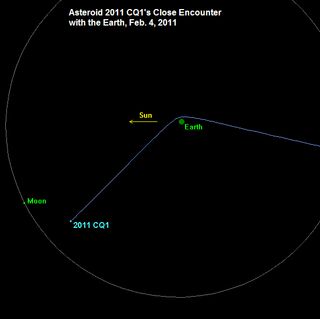Asteroid's Record-Breaking Brush with Earth Changed It Forever

A tiny asteroid that zipped by Earth this month made the closest-ever approach to our planet without hitting it, an encounter that changed its place in our solar system forever, NASA scientists say.
The asteroid, called 2011 CQ1, came within 3,400 miles (5,471 kilometers) of Earth on Feb. 4. Astronomers with NASA's Near-Earth Object office now say the flyby set a record for a space rock.
"This object, only about 1 meter in diameter, is the closest non-impacting object in our asteroid catalog to date," wrote astronomers Don Yeomans and Paul Chodas in a post-flyby analysis. Both scientists work in the NEO office, at NASA's Jet Propulsion Laboratory in Pasadena, Calif.
Asteroid 2011 CQ1 was discovered only 14 hours before its close approach, which occurred over the mid-Pacific Ocean, but it never posed a threat to the planet because of its small size: 4 feet (1.3 meters) wide. Had it entered Earth's atmosphere, it would have broken apart before reaching the ground, NASA scientists said.
Record-setting asteroid encounter
The asteroid's flyby of Earth has changed its orbit, according to Yeomans and Chodas.
Before its Earth encounter, asteroid 2011 CQ1 was one of the solar system's so-called Apollo-class asteroids, whose orbits around the sun are mostly outside the orbit of Earth. [5 Reasons to Care About Asteroids]
But during the Feb. 4 flyby, Earth's gravitational pull warped the flight path of 2011 CQ1. Now the asteroid will spend "almost all of its time inside the Earth's orbit" in what scientists call an Aten-class orbit, explained Yeomans and Chodas.
Get the Space.com Newsletter
Breaking space news, the latest updates on rocket launches, skywatching events and more!
The Earth's gravity pulled asteroid 2011 CQ1 about 60 degrees off its original flight path, they added.
February's asteroid flybys
Asteroid 2011 CQ1 was the first of two asteroids to zip past Earth within a span of six days. Another space rock – the car-size asteroid 2011 CA7 – came within 64,300 miles (103,480 km) of Earth when it passed by on Feb. 9.
Astronomer Richard A. Kowalski of the Catalina Sky Survey discovered asteroid 2011 CQ1 just before its flyby, and scientists at Remanzacco Observatory in Italy snapped a photo of the object ahead of the close pass.
NASA and other scientists monitor the skies for asteroids or comets with orbits that cross that of the Earth in order to track near-Earth objects that could pose an impact threat to our planet. Tiny asteroids like 2011 CQ1 are difficult to spot but pose no threat to Earth.
"There is likely to be nearly a billion objects of this size and larger in near-Earth space, and one would expect one to strike Earth's atmosphere every few weeks on average," Yeomans and Chodas wrote. "Upon striking the atmosphere, small objects of this size create visually impressive fireball events but only rarely do even a few small fragments reach the ground."
You can follow SPACE.com Managing Editor Tariq Malik on Twitter @tariqjmalik.
Join our Space Forums to keep talking space on the latest missions, night sky and more! And if you have a news tip, correction or comment, let us know at: community@space.com.

Tariq is the Editor-in-Chief of Space.com and joined the team in 2001, first as an intern and staff writer, and later as an editor. He covers human spaceflight, exploration and space science, as well as skywatching and entertainment. He became Space.com's Managing Editor in 2009 and Editor-in-Chief in 2019. Before joining Space.com, Tariq was a staff reporter for The Los Angeles Times covering education and city beats in La Habra, Fullerton and Huntington Beach. In October 2022, Tariq received the Harry Kolcum Award for excellence in space reporting from the National Space Club Florida Committee. He is also an Eagle Scout (yes, he has the Space Exploration merit badge) and went to Space Camp four times as a kid and a fifth time as an adult. He has journalism degrees from the University of Southern California and New York University. You can find Tariq at Space.com and as the co-host to the This Week In Space podcast with space historian Rod Pyle on the TWiT network. To see his latest project, you can follow Tariq on Twitter @tariqjmalik.
